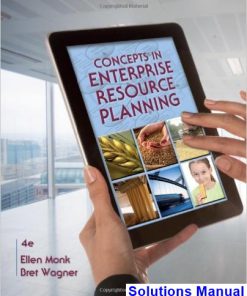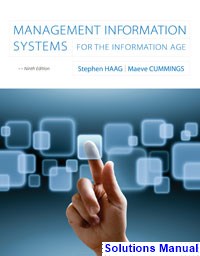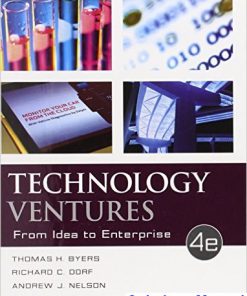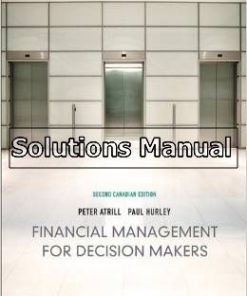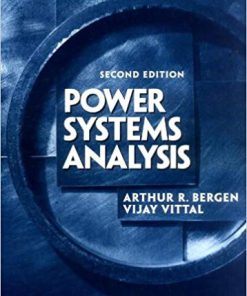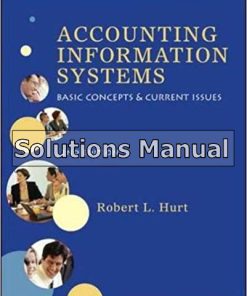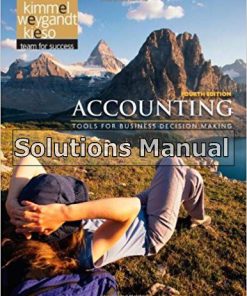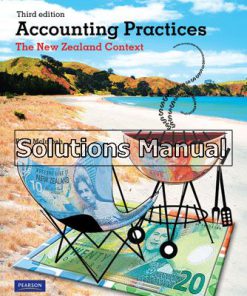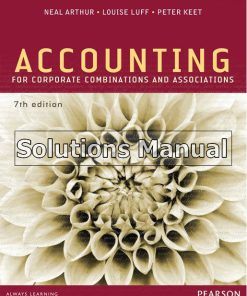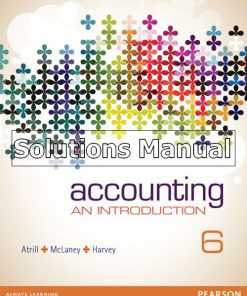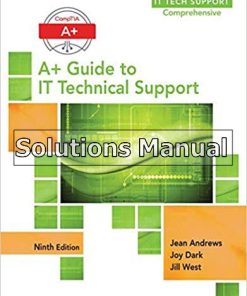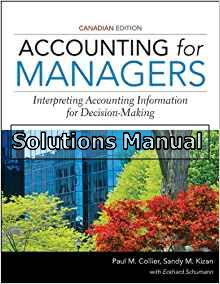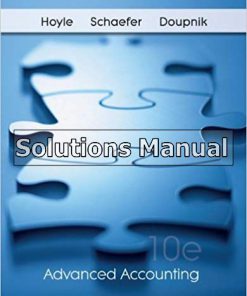Enterprise Systems For Management 2nd Edition Motiwalla Solutions Manual
$50.00 Original price was: $50.00.$26.50Current price is: $26.50.
Enterprise Systems For Management 2nd Edition Motiwalla Solutions Manual.
This is completed downloadable of Enterprise Systems For Management 2nd Edition Motiwalla Solutions Manual
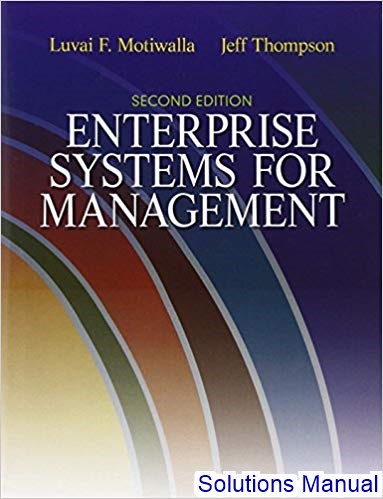
Product Details:
- ISBN-10 : 0132145766
- ISBN-13 : 978-0132145763
- Author; Luvai Motiwalla (Author), Jeffrey Thompson (Author)
An approach to understanding and implementing ERP systems for success in today’s organizations.
Motiwalla teaches readers the components of an ERP system, and the process of implementing ERP systems within a corporation to increase the overall success of the organization. This text also places major importance on the strategic role of ERP systems in providing a platform for improved business operations and productivity.
The second edition reflects the nature of today’s enterprise systems.
Table of Content:
Acknowledgments xvii
Introduction to Enterprise Systems for Management 1
Opening Case: Hershey’s Enterprise 21 Project 2
Information Systems in Organizations 4
Role of IS in the Enterprise 6
Information Silos and Systems Integration 7
Enterprise Resource Planning (ERP) Systems 7
What is an ERP? 7
Evolution of ERP 9
Role of ERP in Business 10
ERP System Components 12
ERP Architecture 13
e-Business and ERP 16
Benefits and Limitations of ERP 17
ERP Implementation 18
ERP Life Cycle 19
ERP Implementation Strategies 20
Software and Vendor Selection 21
Operations and Post-Implementation 22
People and Organization 23
Project Management 23
Role of Consultants 23
Change Management 24
Business Process Reengineering 25
Global, Ethical, and Security Management 25
ERP Vendors 26
Key Vendors 26
Software Extensionsand Trends 27
Implications for Management 28
Real World Case: Rolls Royce’s ERP Implementation 33
Systems Integration 35
Opening Case: Air Cargo’s e-Enterprise System 36
Functional Silos 38
Horizontal Silos 38
Vertical Silos 39
Business Process and Silos 40
Evolution of IS in Organizations 42
IS Generations 44
IS Architectures 45
IS Functionalization 46
Systems Integration 47
Logical versus Physical SI 47
Steps in Integrating Systems 48
Benefits of System Integration 49
Limitations of System Integration 50
ERP and Systems Integration 51
ERP’s Role in Logical Integration 51
ERP’s Role in Physical Integration 52
Implications for Management 53
Real-World Case: Systems Integration at UPS Corp. 56
Enterprise Systems Architecture 58
Opening Case: Nestle’s ERP Implementation 59
ERP Modules 61
Production Module 63
Purchasing Module 63
Inventory Management Module 64
Sales and Marketing Module 64
Finance Module 64
Human Resource Module 64
Miscellaneous Modules 64
Benefits of Key ERP Modules 65
ERP Architecture 66
Layered Architecture Example 67
Types of ERP Architectures 71
Two-Tier Architectures 71
Benefits and Limitations 73
Web-Based Architectures 74
Service-Oriented Architectures 76
Implications for Management 79
Real-World Cases: Wipro and MBH 81
Development Life Cycle 85
Opening Case: Of Men and Mice: An ERP Case Study 86
Systems Development Life Cycle 87
Traditional SDLC 88
Rapid SDLC Approaches 91
ERP Implementation Life Cycle 92
ERP Implementation Plan 93
ERP Implementation Methodology 93
Traditional ERP Life Cycle 94
Rapid ERP Life Cycles 99
ERP Life Cycle versus SDLC 103
Implications for Management 105
Real-World Case: Two Short Cases: OilCO & ExploreCO 108
Implementation Strategies 112
Opening Case: Aquatech International Corporation 113
ERP Components 114
Hardware 114
Software 115
People Resources 117
Third Party Products 117
Why Are They Needed? 117
Integration with ERP 118
Strategic Partners 118
Middleware 118
Support 119
Database Requirements 119
Understanding Transactional and Reporting Needs 119
Selecting the Database 119
Staffing and Database Administration 120
ERP Approaches 120
Governance 120
Implementation Methodology 123
What is a Vanilla Implementation? 124
Why Would You Consider a Vanilla Implementation? 125
When Should You Consider Modifying an ERP? 125
Benefits and Drawbacks 125
ERP Implementation Examples 126
Platform Issues 127
Servers 128
Network 128
Security 128
Disaster Recovery and Business Continuity 128
Implications for Management 129
Real-World Case: United States Army 131
Software and Vendor Selection 136
Opening Case: Oracle Wins Out Over SAP at Welch’s 137
Vendor Research 138
Matching User Requirements to Features 141
Request for Bids 142
Vendor Analysis and Elimination 142
Contract Management and License Agreements 144
Implications for Management 145
Real World Case: Enterprise Solutions for Fruit and Vegetable Beverage Manufacturing 146
Operations and Postimplementation 156
Opening Case: Hugger-Mugger ERP Implementation 157
Go-Live Readiness 159
ERP Training 161
Stabilization 163
Postproduction Support 165
Knowledge Transfer 167
Implications for Management 169
Real-World Case: Hewlett-Packard SAP Implementation 171
Program and Project Management 189
Opening Case: ABC Manufacturing: A Hypothetical Case in Unresolved Issues 190
Project Team 192
Module Experts and Subject Matter Experts 194
Project Leadership 195
Critical Success Factors 198
Decision-Making Process 198
Project Scope 199
Teamwork 199
Change Management 200
Implementation Team & Executive Team 200
Managing Scope Creep 202
Implications for Management 203
Real-World Case: Human Resource Implementation at the Smithsonian Institute 205
Organizational Change and Business Process Reengineering 211
Opening Case: FoxMeyer Drugs 212
Reason for Change 213
Organizational Commitment 214
Change Management 215
Organization Project Management Maturity Model (OPM3) 215
Business Process Change 217
Business Process Re-engineering 217
BPR Methodology 218
Current BPR Tools 220
Project Organization 222
Project Roles and Responsibilities 224
Implications for Management 226
Real-World Case: Nike ERP Implementation 228
Global, Ethics and Security Management 245
Opening Case: Outsourcing at FERC 246
Outsourcing 247
What is Outsourcing? 247
Outsourcing Drawbacks 250
Offshore Outsourcing 250
Software as a Service (SaaS) 253
Outsourcing Best Practices 255
Ethics 257
Ethical Principles 258
Code of Ethics for ERP 262
Legal Issues 264
Software Licensing 264
Implementation Partners and Consultants 265
Audit 265
SOX Compliance and EU Regulations 265
Security 268
Disaster Recovery and Business Continuity Planning 272
Implications for Management 273
Outsourcing 273
Real-World Case: TJX Security Breach 277
Supply Chain Management 278
Opening Case: Managing the e-Supply Chain at Cisco Systems 279
Supply Chain Management 281
SCM Drivers 284
SCM Flows 285
SCM Processes 287
E-Business and Supply Chain Management (E-SCM) 288
E-SCM Components 289
E-Procurement 291
Collaborative Design and Product Development 292
ERP System and Supply Chain 293
Integration 296
Supply Chain Integration 296
Integrating ERP and SCM Systems 297
Enterprise Application Integration 298
Phases of Enterprise Application Integration Process 299
Benefits of Enterprise Application Integration 300
Implications for Management 300
Real World Cases: Zara and The Limited Brands 303
Customer Relationship Management 306
Opening Case: Walt Disney CRM Strategy 307
What Is Crm? 309
CRM Evolution 309
CRM Today 311
Types of CRM 312
Customer Relationship Processes 313
CRM Delivery Processes 314
CRM Support Processes 314
CRM Analysis Processes 315
CRM Technology 315
CRM Components 316
CRM Packages and Vendors 317
CRM Architecture 317
On-Demand CRM 319
CRM Life Cycle 319
Implications for Management 321
Real World Case: Plexipave: A Failed CRM Implementation 324
Index 327
People Also Search:
enterprise systems for management motiwalla
enterprise systems for management 2nd edition motiwalla
enterprise systems for management
enterprise systems for management 2nd edition
enterprise systems for management 2nd edition solution manual download pdf
enterprise systems for management 2nd edition download scribd
Instant download after Payment is complete
You may also like…
Information Technology
Management Information Systems for the Information Age 9th Edition Haag Solutions Manual
Solutions Manual
Financial Management for Decision Makers Canadian 2nd Edition Atrill Solutions Manual
Solutions Manual
Accounting Information Systems 2nd Edition Hurt Solutions Manual
Related products
Solutions Manual
Solutions Manual
Solutions Manual
Accounting An Introduction 6th Edition Atrill Solutions Manual
Solutions Manual
A+ Guide to IT Technical Support Hardware and Software 9th Edition Andrews Solutions Manual
Solutions Manual




